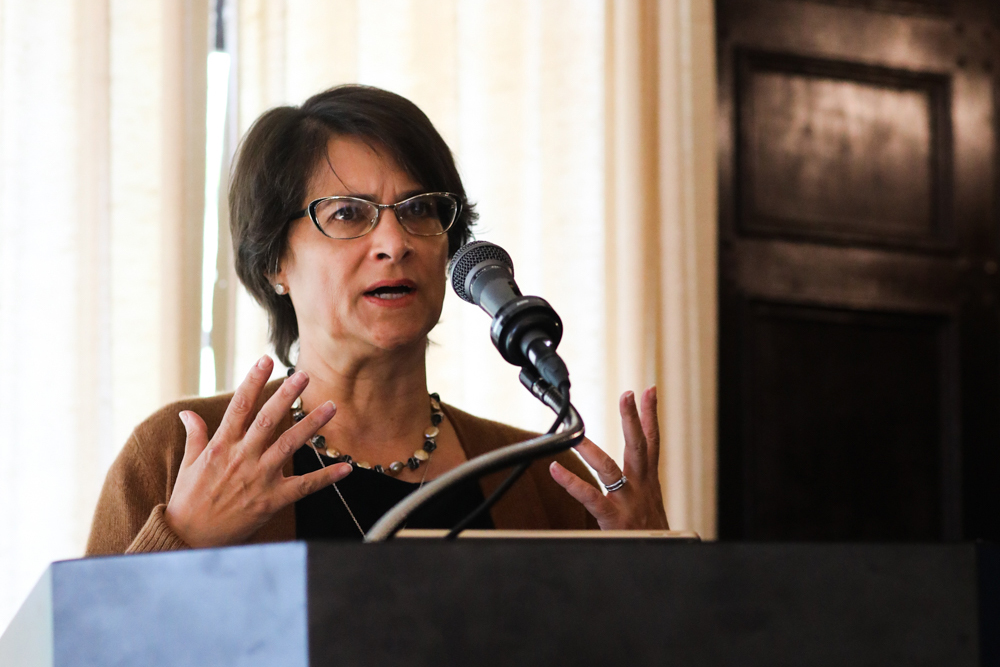Birthright citizenship may have been codified by the Fourteenth Amendment, but it came about not because of far-sighted legislators but through the concerted and prolonged efforts of the people—specifically African Americans—who had long been denied it. This struggle, which began decades before the amendment was ratified in 1868, is at the core of the current debate over citizenship. As a little known but vital part of history, it was also the topic of historian Martha S. Jones’s latest book, Birthright Citizens: A History of Race and Rights in Antebellum America, and of her Constitution Day talk at BC Law on September 19.
Speaking to a standing-room-only crowd, Jones, Society of Black Alumni Presidential Professor at Johns Hopkins University, opened by acknowledging the present-day debate over birthright citizenship, especially as it relates to issues of immigration. Then she dove deep into its fascinating history, discussing the lives and struggles of the free African Americans who fought for their rights and established such transformational legacy.
In her lecture, sponsored by BC’s Clough Center for the Study of Constitutional Democracy and BC Law’s Legal History Roundtable, Jones focused on a key figure in her book, George Hackett, a free man of color whose lifelong activism spanned key decades of the legal and legislative battle. “As early as the 1820s, men like Hackett are facing a profound question,” she explained. “Who are they before the law?”
It was a question that was to shape Hackett’s life. Born in Baltimore in 1802, he played a central role in the fight for citizenship. The son of an African Methodist Episcopal minister, he was raised as an educated member of a growing society of free people of color who were governed by an inconsistent patchwork of laws that varied state to state and city to city.
“Could you own a dog? Could you own a gun?” From these questions, said Jones, the Hacketts and their peers tried to understand their rights. “They studied the Constitution, trying to discern where they fit in.”
The owner of livery stable, George Hackett was a thriving member of the large emancipated working class that was well established in the antebellum city. However, after a series of reversals—including a disastrous flood that destroyed his stable—he joined the US Navy and left Baltimore.
As a member of the crew of the USS Constitution, he encountered firsthand the inconsistencies in how African Americans were treated under the law. While on board, sailors received more or less equal treatment. Both white and African American sailors could be flogged, for example, and African American sailors could testify against the interests of white sailors. Once the ship was docked, however, the wildly varying laws of different cities, even within the United States, determined a range of rights and freedoms. As a free person of color, for example, Hackett would have been jailed if he had ventured onto land while his ship was in the port of Charleston.
Finally coming ashore in Nantucket in 1841, two weeks before fellow Baltimorean Frederick Douglass would give his first anti-slavery speech there, Hackett might have been tempted to remain up north and join the burgeoning abolition movement. He returned to Baltimore, however, and took advantage of the relatively liberal city laws to wage a succession of legal cases. He successfully fought a white man in court and, as a deacon in his church, subsequently went to court for members of his congregation.
“By asserting himself, hiring the right kinds of lawyers who will allow him and his congregants to testify,” said Jones, he promoted people of color “carrying themselves like people who have rights.”
This precedent was noticed, she explained. And while a state constitutional convention, held in 1850, sought specifically to limit these rights, the issue was never voted on. In part, Jones pointed out, that was because Baltimore relied on its population of 75,000 free people of color as a work force. “They were an engine of prosperity,” said Jones. “What man would work for wages if he didn’t have the ability to go into a courthouse and argue for the fruits of his labor?”
Hackett went on to form the first militia of free people of color and, later as a taxpayer, to sue for the establishment of public schools for people of color, cementing this precedent. A member of the Republican Party, who insisted on voting rights in 1964, Hackett did not live long enough to join in the national celebration of emancipation held in Baltimore in 1870, when the Fifteenth Amendment was ratified, but his lifelong efforts surely helped bring it about, in Jones’s view. As she said, “I like to think he was watching.”


